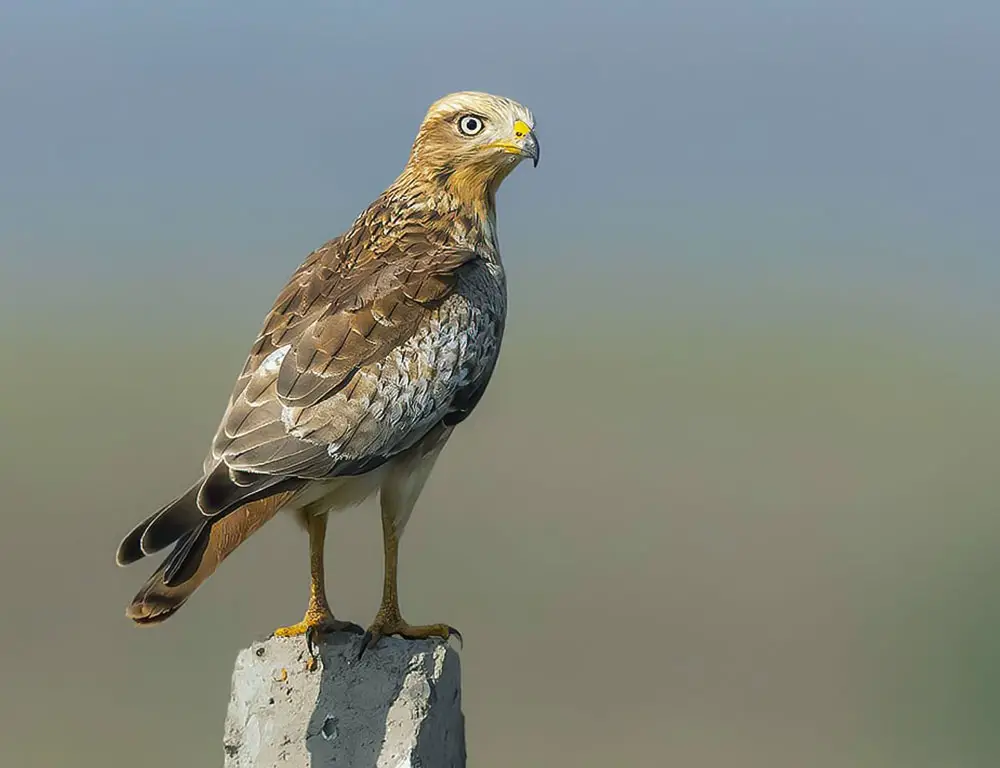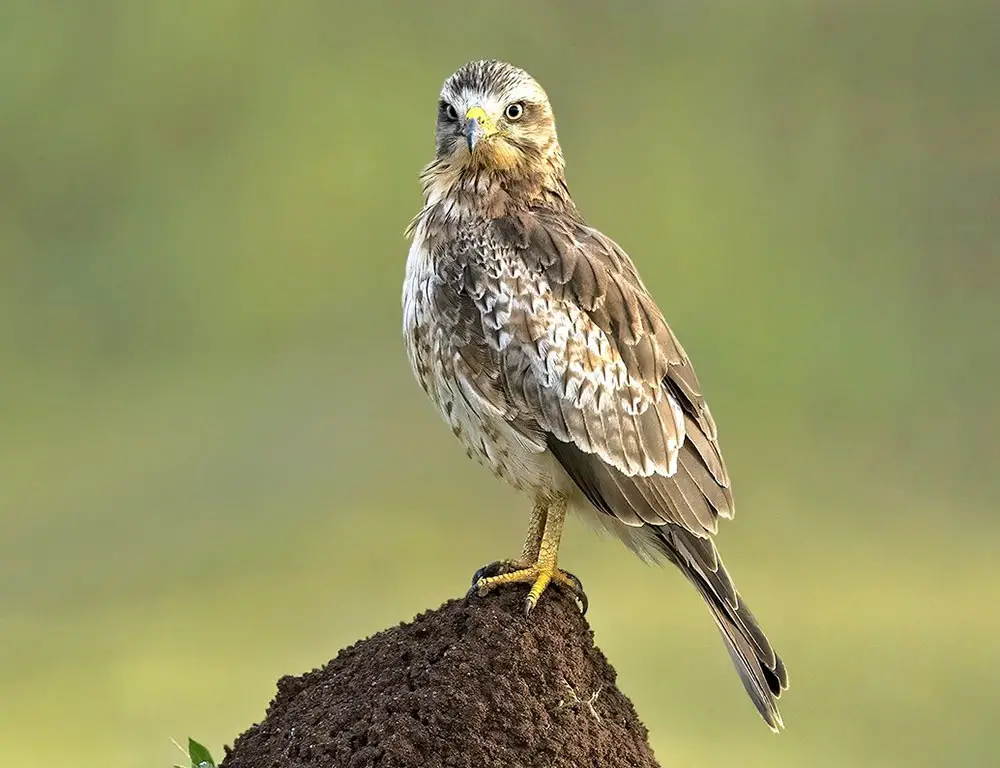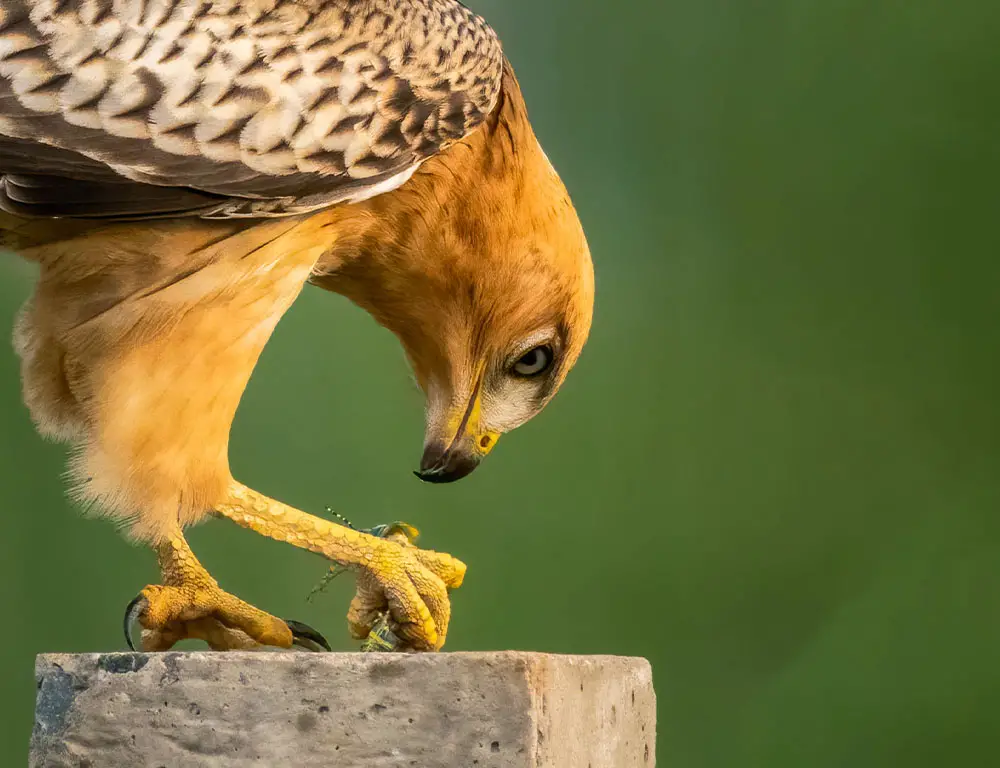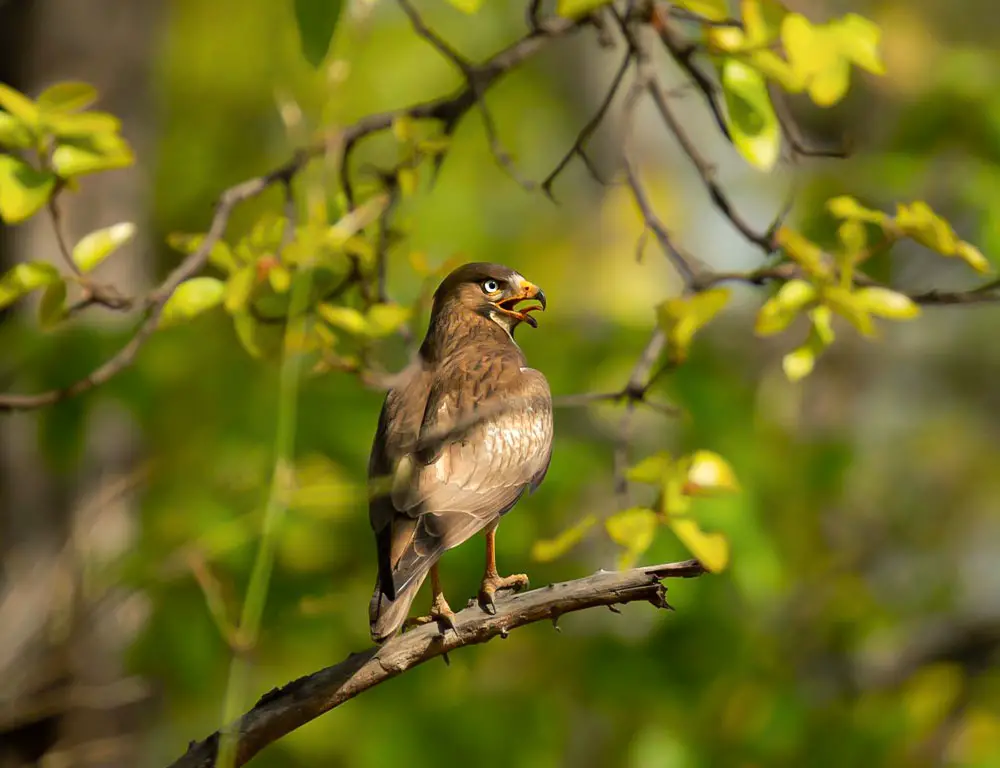In the vast tapestry of avian diversity, the White-Eyed Buzzard stands out with its striking white iris, a unique feature distinguishing it from other buzzard species.
Native to South Asia, this medium-sized bird of prey favors open country and woodland habitats, where it can be observed gracefully soaring above fields and forests, its keen white-ringed eyes scanning for prey.
With a diet primarily comprising insects and small mammals, it plays a crucial role in its ecosystem. Despite its captivating appearance and behavior, the White-Eyed Buzzard, like many wildlife species, faces habitat loss and climate change challenges.
As we explore the intricacies of this beautiful bird, it reminds us of our responsibility to appreciate and preserve nature’s rich diversity.
Physical Characteristics of the White-Eyed Buzzard

The White-Eyed Buzzard (Butastur teesa) boasts several distinct physical characteristics that contribute to its unique appearance and hunting capabilities:
Size
They possess a medium-sized body structure, typically measuring 46 to 56 centimeters long.
Wingspan
With a wingspan ranging from 109 to 136 centimeters, they exhibit impressive aerial capabilities despite their relatively small size.
Coloration
Their coloration is characterized by a greyish-brown back and wings, contrasting sharply with a creamy-white underbelly and chest. This stark difference in coloration aids in camouflage and recognition.
Eyes
Perhaps the most striking feature is their white eyes, where their name is derived. These piercing white irises are encircled by a conspicuous yellow eye ring, adding to their visual allure and aiding in visual communication.
Sexual Dimorphism
Subtle variations in appearance can distinguish males and females of the species. Males often exhibit paler coloring, while females may display more defined streaks on their bodies, aiding in sexual identification.
Legs and Talons
They possess strong legs terminating in powerful talons, essential for grasping and subduing prey during hunting. Additionally, their hooked beaks facilitate tearing apart food for consumption.
Habitat and Distribution of the White-Eyed Buzzard

The White-Eyed Buzzard (Butastur teesa) is primarily found in South Asia, with a widespread distribution across several regional countries.
Here’s a closer look at their habitat and distribution:
Habitat
These birds of prey typically inhabit open country with scattered trees. They are not commonly found in dense forests or high altitudes but prefer lowland environments such as agricultural lands and grasslands.
Additionally, they are adaptable and can also be spotted near human settlements.
Distribution
- India: White-Eyed Buzzards are widespread throughout India.
- Pakistan: They are common in Pakistan.
- Nepal: White-Eyed Buzzards are frequent in Nepal.
- Bangladesh: They are regularly found in Bangladesh.
- Sri Lanka: Although less common, they also inhabit certain areas of Sri Lanka.
Variations in Habitat and Distribution
- India and Pakistan: In these countries, they are commonly seen around wetlands.
- Nepal and Bangladesh: In the drier parts of these countries, they tend to stick to more arid regions.
Regional Differences
There are subtle differences between White-Eyed Buzzards based on their location. For example, those from northern India are often larger than those from southern areas.
These variations could be attributed to differing climatic conditions and regional prey availability.
Behavior and Diet of the White-Eyed Buzzard

The White-Eyed Buzzard (Butastur teesa) exhibits various behaviors and has a varied diet, making it an opportunistic and adaptable predator. Here’s an overview:
Behavior
- Hunting Strategy: White-Eyed Buzzards typically hunt during the morning and evening hours. They are known for their remarkable hunting strategy, which involves hovering at a height and then swooping down on unsuspecting prey.
- Scavenging: These birds have been observed scavenging on leftovers from other carnivores’ kills, showcasing their opportunistic nature.
- Adaptability: They adjust their hunting techniques and feeding habits based on what’s readily available in their habitat, displaying flexibility in their behavior.
Diet
- Insects: White-Eyed Buzzards feed mainly on insects, including those in termite swarms during monsoons.
- Small Mammals: Their diet also includes small mammals like rodents.
- Reptiles: They prey on reptiles as well.
- Smaller Birds: Additionally, White-Eyed Buzzards occasionally feed on smaller birds.
- Carrion: They have been known to indulge in carrion when available.
Seasonal Variation
The White-Eyed Buzzard’s diet may vary seasonally, such as during the monsoon season when they feast on termite swarms. This adaptability ensures their survival and helps them thrive in diverse environments.
Conservation Status of the White-Eyed Buzzard

The White-Eyed Buzzard (Butastur teesa) is currently classified as “Least Concern” on the IUCN Red List, indicating that it is not facing immediate threats to its survival. However, there are still conservation concerns that need attention:
Population Trend
The population trend of White-Eyed Buzzards has remained generally stable across their range over the past two decades, with estimates ranging from 1 to 2 million individuals.
Conservation Challenges
- Pesticide Exposure: Like many birds of prey, White-Eyed Buzzards are susceptible to pesticide exposure. They often feed on rodents and insects that may carry harmful chemicals from agricultural practices, posing a risk to their health and survival.
- Deforestation: Loss of nesting sites due to deforestation is another significant threat to the species. Rapid development and agricultural expansion in their habitats contribute to the loss of suitable nesting sites, affecting breeding success and population health.
Conservation Efforts
While the species is not currently endangered or threatened, ongoing conservation efforts are necessary to mitigate their threats. These efforts may include:
- Monitoring pesticide use in agricultural areas to minimize exposure to birds of prey.
- We are implementing habitat conservation measures, such as reforestation and protected area designation, to safeguard nesting sites and maintain habitat quality.
- I am researching to understand better the species’ ecology, behavior, and conservation needs.
FAQs
How does the White-Eyed Buzzard hunt?
The White-Eyed Buzzard hunts by hovering at a height, then swooping down on prey, such as small mammals and insects, with remarkable precision.
What are the predators of the White-Eyed Buzzard?
Common predators of the White-Eyed Buzzard include larger birds of prey, such as eagles and other raptors that may compete for resources.
How do White-Eyed Buzzards communicate?
White-Eyed Buzzards communicate using vocalizations and body language, employing calls for mating, territorial defense, and warning signals to alert others of potential threats.
What is the lifespan of a White-Eyed Buzzard?
The average lifespan of a White-Eyed Buzzard in the wild is approximately 15 years, although it may vary due to environmental factors.
Do White-Eyed Buzzards migrate?
White-Eyed Buzzards are primarily sedentary birds, with some individuals exhibiting seasonal movements within their range in search of food or breeding sites.
Conclusion
The White-Eyed Buzzard epitomizes the remarkable diversity of nature and underscores the vital importance of conservation efforts.
Found predominantly across parts of Asia, these raptors play critical roles in their ecosystems, controlling rodent populations and contributing to biodiversity.
Despite their relative abundance, they face threats from habitat loss and human interference. Understanding and appreciating these creatures can foster tremendous respect for our environment.
Whether bird enthusiasts or advocates for preserving Earth’s habitats, we must recognize and protect every species’ role in maintaining ecological balance.
The White-Eyed Buzzard is a testament to this fact—a unique and remarkable creature deserving our protection for future generations to marvel at its splendor.